

Geological activity was discovered on Io during the 1979 flyby by
Voyager 1.
Voyager was photographing and mapping the surface following the discovery of large circular features, made out to be
volcanic calderas.
During an exercise to determine the exact position of the spacecraft by a navigational team at NASA's
Jet Propulsion Laboratory,
images from Voyager were being carefully analysed. During contrast stretching of one image a huge umbrella shaped plume was seen, similar to the one shown in the Voyager 1 image below.
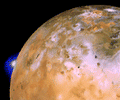
This first plume was calculated to be rising 300km above the horizon and the ejecta was falling back over an area 1000km wide. Further analysis of images brought to light a further eight plumes. The first plume was named Pele after the fiery goddess of Hawaii.
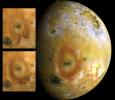
The other plumes were named Prometheus, Volund, Amirini, Maui, Masubi, Marduk and Loki.
The majority of plumes were associated with dark spots which were visible all over the moon, and over 200 of which were seen to exceed 20km in diameter. It is thought that these features are volcanic
calderas .

The abscence of any of the lighter molecules in the atmosphere of Io is also very easy to explain as it's gravity is so weak, the lighter molecules will have bled off into space at a very early time in the moon's history.

A planetary body forms by the smashing together of material left over from the formation of the sun. At first small particles collide and join with other small particles and then these larger particles collide and so on until you have a large planetary sized body. However, each impact generates heat and over time this heat builds up and in larger bodies is coupled with the heat generated as material is compressed near the center of the body. This is accretional heat.
Of the particles which were used to build our solar system, some were unstable radioactive particles. During the building of bodies in the solar system these particles were incorporated into the fabric of the bodies. As these particles decay they give off heat. Since there are a variety of particles, all with differing half lives, this heat source has kept, and will keep, the Earth warm for aeons to come, since it has a fairly insulating outside layer. In the case of smaller bodies such as the Moon or Io, the surface area to volume ratio is much larger so their heat from these sources has been relatively rapidly diffused into space.
So how does Io generate enough internal heat to support geological activity? The answer is
tidal heating.
On Earth we regularly move in and out of line of the gravitational pulls of the Sun and Moon. This causes the familiar phenomenon of tides. Although Io has a circular orbit, and so should not feel any changing gravitational pull from Jupiter during each orbit, it is surrounded by other satellites which are orbiting with different periods. Everytime Io passes one of these satellites it experiences a perturbation in its orbit which is exaggerated by its proximity to the huge planet Jupiter. This leads to a tidal bulge of 100m on Io's surface, compared to that of 1m on Earth.

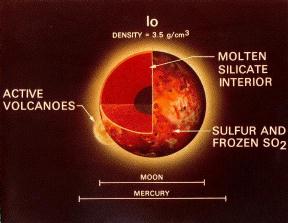
The mottled appearance of Io is due to the presence of sulphur on its surface since sulphur can take a range of colours depending on its temperature. However, Io shows quite substantial relief in places which could not be supported by a sulphurous crust and are not volcanoes. This suggests that at some level there must be some form of strengthening compound, likely to be silicates as found in all the other rocky bodies in the solar system. Tidal heating would keep silica molten at depth within Io, so it is likely that Io has a double layered crust with one sulphurous and one silicate layer.
A simple model of the structure has been proposed. The general layout of Io would be as follows: A partially molten silicate mantle would be topped by a silicate crust that rises to the surface in places to form relief. Above this would lie lakes of molten sulphur topped by a frozen crust of sulphur. Volcanism would occur as silicate eruptions onto the floor of the sulphur lakes, triggering convection currents which would sometimes break through the frozen crust on to the surface.
More recent ground-based infra-red studies have suggested that the lavas are too hot to be molten sulphur. It has been suggested that the lavas are in fact all molten silica, possibly rich in sodium and other substances.


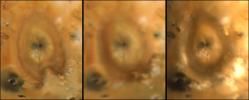
There have also been many new discoveries such as Io having an iron core.
Many detailed observations are now possible from Earth, both from the Hubble Space Telescope and from advanced ground based telescopes here and here.
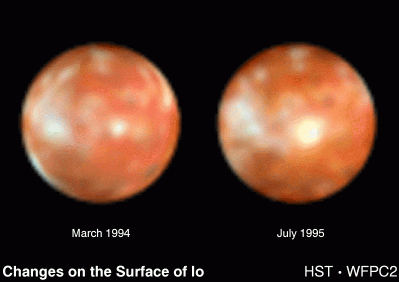

Reference: Charles Frankel, Volcanoes of the Solar System, Cambridge University Press.
by Alexis Busfield
e-mail: ab6198@bristol.ac.uk